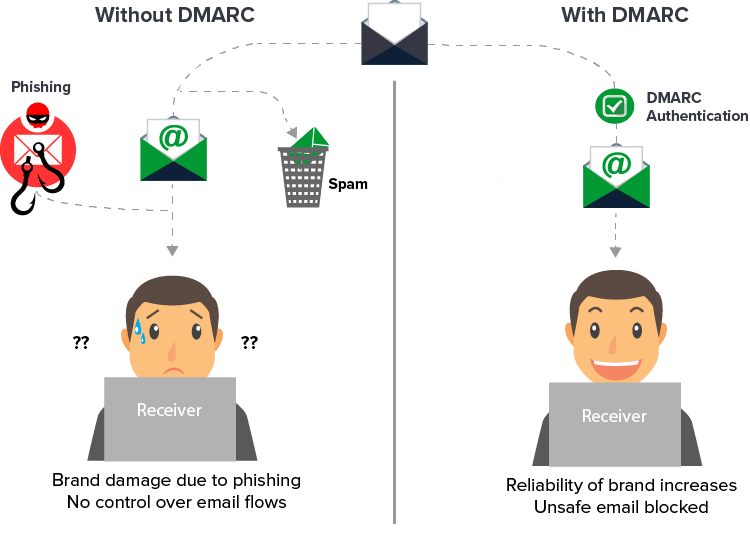The email validation system, known as DMARC (Domain-based Message Authentication, Reporting, and Conformance), is meant to safeguard your company’s email domain from being exploited for phishing, email spoofing, and other cybercrimes.
For email authentication, DMARC records use SPF and DKIM. With DMARC, you can do reporting, which is a critical feature. By publishing a DMARC record in their domain’s DNS, domain owners may see who is sending emails on their behalf.
Using this information, you may receive further information about the email channel. A domain owner may take control of the email sent on his behalf using this information. Your domain may be protected against phishing and spoofing attacks by using DMARC.
You, as the owner of a website, want to be certain that only emails that you have sent will be seen by your visitors or customers. As a result, DMARC is a must for all domain registrants.
DMARC provides email recipients with the assurance that an email they receive from you is authentic and has come from you. In addition to improving email delivery, this prohibits others from utilizing your domain to send emails.
DMARC: A Brief History
In 2012, the DMARC standard was issued for the first time in an attempt to stop email misuse. The DMARC standard was produced by PayPal, Google, Microsoft, and Yahoo! in collaboration with each other.
In order to acquire official standard status, these industry experts joined together to produce an operational specification. The DMARC standard was built on the SPF (Sender Policy Framework) and DKIM (DomainKeys Interoperability Markup Language) authentication methods (Domain Keys Identified Mail).
At its inception, the DMARC system was designed to protect email communications. DMARC was first accepted mostly by finance sector security specialists. Since then, the use of DMARC has grown and expanded throughout the internet. DMARC is becoming more and more accepted by email marketers as a means of enhancing internet security and enhancing email delivery.
All major Internet service providers (ISPs) presently support DMARC. DMARC is now in the process of being accepted as an open standard by the Internet Engineering Task Force (IETF).
What is the Purpose of DMARC?
The email channel has the widest reach as compared to any other medium, with about 5 billion global email accounts. As a result, cyber thieves have a strong interest in using this route for their nefarious activities. Despite increased security measures in previous years, criminality on this channel continues to rise each year. Most hacking and data breaches occur via email.
In this context, domain-based authentication reporting and compliance (DMARC) is a valuable tool for organizations. DMARC makes phishing assaults transparent as well as providing comprehensive visibility into email channels.
DMARC is more powerful: DMARC can mitigate the effect of phishing and malware assaults, prevent spoofing, guard against brand misuse, frauds, and prevent corporate email penetration. DMARC Analyzer makes it easier for organizations to implement DMARC and streamlines that process.
What can DMARC Accomplish For You?
DMARC can protect organizations and their clients against malicious emails sent on their behalf. DMARC provides an organization with access to its email channel’s information. Organizations may use this information to develop and enforce a DMARC policy.
Rejection of DMARC policy to reject protects companies from:
- Customers of the organization are being phished.
- Scams and misuse of a well-known brand
- Ransomware and Malware assaults
- Employees are at risk of falling victim to spear phishing and CEO fraud.
DMARC Analyzer provides enterprises with a comprehensive view of their email channel. DMARC’s ability to obtain complete visibility into the email channel is a major benefit since companies previously only had access to phishing assaults after they had already occurred. With DMARC, phishing attempts may be analyzed and prevented. As a result, clients are more prepared and aware of these threats.
When it comes to email fraud detection, DMARC is the most important tool in the toolbox. Phishing schemes, such as those that send emails on behalf of banks using legitimate-looking websites, are an example. In the minds of customers of that bank, an email claiming that their bank card is no longer valid is a legitimate one.
The link you’re about to click will take you to a shady website. Logging on to this website, which is a perfect replica of the genuine thing, will provide hackers access to your credentials.

